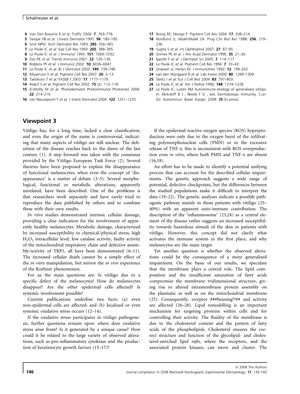Viewpoint 3
February 2008
in “
Experimental dermatology
”
melanocytes oxidative stress epidermal cells systemic cells intrinsic cellular damage metabolic dysfunction membrane alterations cholesterol cardiolipin respiratory chain reactive oxygen species ROS membrane lipid peroxidation signal transduction immunogenic antigens immune activation hair follicle niche lipoic acid supplementation skin cells cell damage metabolism issues cell membrane changes energy production chain free radicals lipid peroxidation cell signaling immune triggers immune response hair follicle environment lipoic acid

TLDR Oxidative stress plays a significant role in vitiligo, and both skin and non-skin cells may be involved.
The document discusses the complexities of vitiligo, a condition characterized by the loss of melanocytes, the cells responsible for skin pigmentation. Despite advances in understanding, many aspects of vitiligo remain unclear, including the exact cause of melanocyte disappearance and whether other epidermal or systemic cells are affected. The document highlights that oxidative stress, both localized and systemic, is a significant factor in vitiligo pathogenesis. It also suggests that non-epidermal cells are involved and that oxidative stress may arise from various sources, including intrinsic cellular damage and metabolic dysfunction. The paper proposes that membrane alterations, particularly involving cholesterol and cardiolipin, could be a unifying mechanism for the various cellular impairments observed in vitiligo. This includes affecting the stability and activity of the respiratory chain, increasing reactive oxygen species (ROS) production, and promoting membrane lipid peroxidation. These changes may lead to altered signal transduction and the generation of new, immunogenic antigens, potentially triggering immune activation. The document also speculates on the role of the hair follicle niche in melanocyte production and the possible impact of vitiligo on this process. The effectiveness of cardiolipin components or lipoic acid supplementation in experimental models supports the proposed hypothesis.




